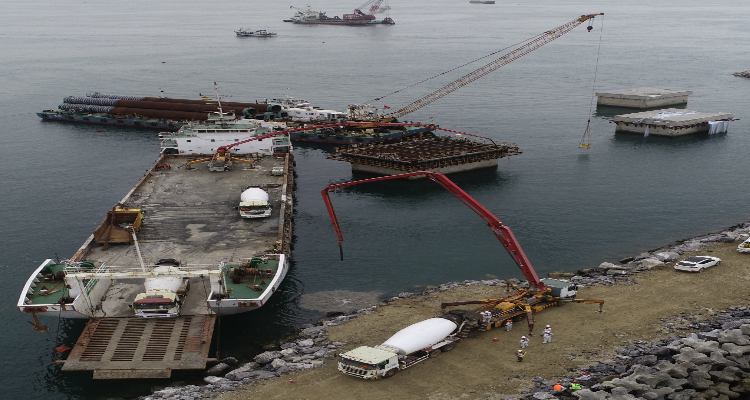CASE STUDY: TEMA LNG TERMINAL COMPANY

THE COMPANY:
- Company: Tema LNG Terminal Company (TLTC)
- Region: West Africa
- Country: Ghana
- Sector: Midstream Gas
- Technology: TLTC is an LNG import terminal consisting of a permanently moored Floating Storage Unit (FSU) and Floating Regasification Unit (FRU).
- Size: USD46.7m
- Investors: AIIF3 in conjunction with local partner Lyndhurst, Helios Investment Partners and Gasfin.
- Investment: Equity
TLTC’S STORY
The Tema LNG Terminal Company, is a new liquified natural gas [LNG] facility located at the Port of Tema within the Greater Accra Region which lies in the eastern part of Ghana. The project began construction in 2018 with operations commencing in March 2021.
The facility will deliver natural gas into the national gas transmission network through a connection which is being constructed as part of the project, comprising a 600m subsea pipeline and a 6.5km onshore pipeline. TLTC has entered into a 17-year terminal use agreement with Shell BV, who will process LNG through TLTC and then sell the processed natural gas output to the Ghanaian National Petroleum Corporation (GNPC) under a gas sales agreement. GNPC supplies natural gas to the country’s gas-fired power generation plants. Increased supply of gas will support the conversion of generation plants from oil to gas – a cleaner fuel.
The design is based on an innovative combination of a purpose-built Floating Regasification Unit and an existing LNG carrier (being converted to a storage facility). It will provide Ghana with all the functionality of a new, large-scale FSRU-based terminal, but at a significantly reduced cost.
TLTC is strategically located in Tema close to several existing power stations and it will alleviate supply constraints within the gas transmission network for the area. The project will improve the reliability of gas supply, reduce the cost of power generation and spur the development of new gas-based industries. As a first mover, the Tema project is a potential platform from which sponsors can serve the West African LNG market.
IMPACT HIGHLIGHTS
- LTC will be the first LNG import terminal in West Africa. It will initially process about 1.7 million tonnes (Mt) of LNG a year, sending out approximately 240MMscfd (million cubic feet per day) of natural gas.
- The gas price is set at a level that is significantly cheaper than all gas supply alternatives in Ghana, therefore reducing the cost of electricity production for the country.
THE ROLE PLAYED BY PRIVATE EQUITY
As long-term infrastructure investors, AIIM recognised an opportunity to help expand cleaner energy sources in Africa by investing in TLTC through its African Infrastructure Investment Fund 3 (AIIF3), which targets infrastructure investments in the power, transport and midstream energy sectors across sub-Saharan Africa.
Roughly 90% of gas demand in Ghana derives from power generation, with the balance coming from industrial users. Ghana’s power demand is expected to grow at a 6%+ CAGR over the next five years. Tema LNG, which reduces the overall weighted average cost of power in Ghana, will ensure that increased power demand can be met economically.
The equity investment in Tema LNG comes entirely from the private sector, in conjunction with debt from international banks.
LNG is one of the fastest-growing commodity trades in the world and Africa is well placed to capitalise on this cleaner energy trend due to its vast gas deposits, with much yet to be brought to commercial development. The realisation of the first LNG terminal in West Africa is testimony to the increasingly important role of the private sector in expanding cleaner and more reliable energy across the continent.
A FORCE FOR GOOD
Gas produced from TLTC will be used to generate enough electricity to power up to an estimated 30% of Ghana’s generation capacity, thereby ensuring a significant portion of the population in Ghana can benefit from cleaner and more economical energy sources.
TLTC is also committed to providing local employment opportunities and Engineering, Procurement and Construction (EPC) contractors were required to develop and implement a local content plan. These plans required contractors to recruit locally, provide training and development to build capacity, as well as procure materials and services locally. At peak capacity, TLTC employed over 500 project staff, and on average across the construction period, the staff comprised an average of 66% locals. Approximately 210 artisans from the local communities were also trained and employed on the project.
As TLTC moves from the construction to operation phase, a formal Corporate Social Responsibility (CSR) programme will be developed. The key focus areas identified through extensive engagement with residents, the traditional councils and local authorities are:
- Welfare facilities (including waste disposal and sanitation facilities);
- Education; and
- Community Health (including neonatal care).
Projects that TLTC have already initiated, include construction of toilet facilities along the pipeline route to serve the local communities, educational programmes in schools focusing on the environment, climate change and sustainable food production, as well as deployment of waste bins and skips strategically placed for collection by a waste management company.
